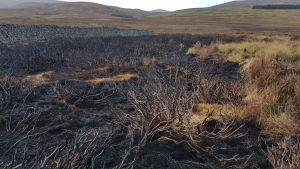Eyes on the Bog provides scientifically robust, repeatable, affordable and long-term peatland monitoring.
Monitoring the health of our peatlands in the long term is critical to understanding the impacts of peatland degradation and the effectiveness of habitat restoration and sustainable management. Whilst restoration does have many fast-acting benefits for peatlands, ecosystem recovery involves a long trajectory of smaller changes which progress over many years. Unfortunately, much funding for peatland restoration doesn’t require or provide support for long-term monitoring and there is a need for simple, affordable methods which are also repeatable and scientifically robust. As a solution, the IUCN UK Peatland Programme created ‘Eyes on the Bog’.
What is Eyes on the Bog?
Eyes on the Bog involves a suite of methods using simple techniques and affordable technology to capture information from a range of metrics which are important in understanding peatland health, including:
-
behaviour of the water table;
-
peat subsidence or accumulation;
-
carbon loss or carbon capture;
-
condition of the peat soil;
-
vegetation composition;
-
surface structure/microtopography;
-
historical context of change and possible current trajectories.
Data from Eyes on the Bog provide reliable information which may be used to effectively inform management interventions, help test long-term climate predictions and inform assumptions about the condition and function of UK peatlands.
The accessibility of Eyes on the Bog also means it can be easily employed by volunteers without specialist scientific training, and is an effective community engagement and citizen science tool. By helping to monitor the health of their local peatland, members of the community feel they are more connected to their local landscapes and able to make a difference. Totemic markers which are sympathetic to the landscape and installed on publicly accessible sites provide quality assurance of the monitoring setup and can be used to inspire and engage the wider community. We encourage the use of Eyes on the Bog branding and incorporation of the Eyes on the Bog logo into totemic markers. Please contact info@iucn.org.uk for free access to the logo, brand guidelines and design specifications.

For an overview of Eyes on the Bog, download our introductory leaflet.
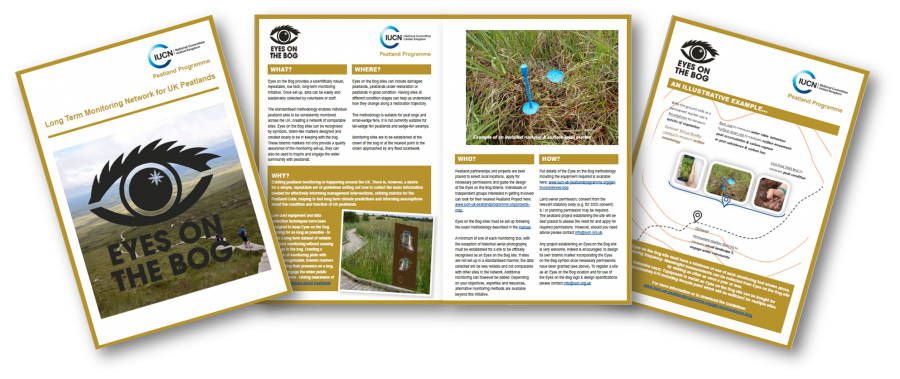
How Eyes on the Bog works
Eyes on the Bog involves five key methods. The first three methods below are suitable for all peatland habitats and the last two are suitable for bog habitats only. The science behind the methods and full instructions are provided in the Eyes on the Bog manual.
-
Historic maps and aerial photography are useful tools for ‘monitoring back in time’. Understanding historic changes in peatland condition over time can help predict future changes as well as assessing the effectiveness of restoration interventions. The Eyes on the Bog manual provides a case study from Featherbed Moss in the Peak District which illustrates the use of historic aerial photography to map erosion gullies, understand their impact on the vegetation community over time, and assess the impact of recent gully blocking.
-
Fixed point photography is another useful method for monitoring changes in peatland condition over time. Modern smartphones can collect high-quality images from which many plants can be identified to species level. Virtual reality cameras are increasingly affordable and provide immersive 360 views of peatlands. Stereo VR can record the surface morphology of bog habitats, another useful way of assessing their condition, as highlighted in our Sphagnum species showcase.
-
Surface-level rods were inspired by the Holme Fen post in Cambridgeshire, an iron pillar buried in 1848 which now stands more than 4 m above the surface due to loss of the surrounding peat. Surface-level rods are a much smaller version which record the same thing. They are buried in the peat with their tops level with the surface and observed over time to see whether they become more visible as peat is lost, or disappear as peat accumulates.

-
Rust rods look similar to surface-level rods but are used to understand the behaviour of the water table. In a healthy bog, the water table should stay close to the surface and is unlikely to drop even as far as 30 cm. When left in the peat for 3 months or more, rust rods develop a band of rust which indicates how far the water table has dropped.
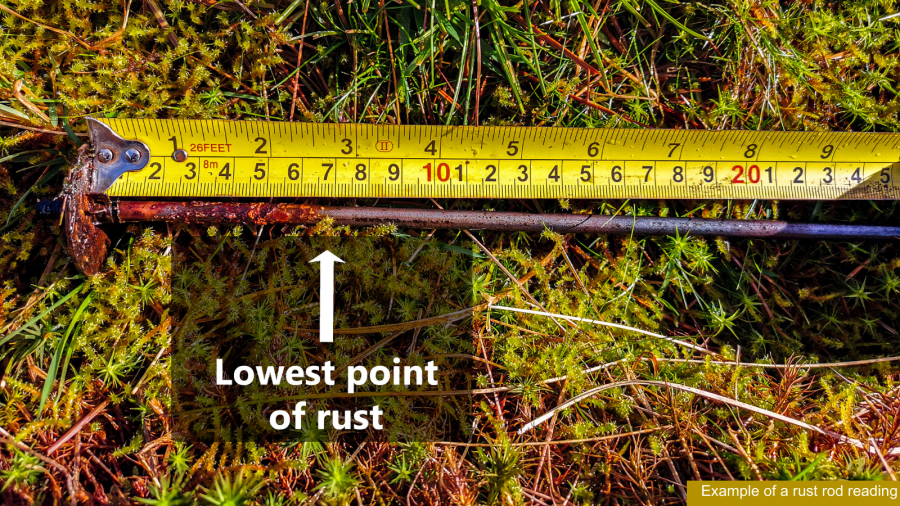
-
The von Post soil test is a simple method which involves squeezing a handful of peat to see how much escapes between the fingers. The more degraded the peat, the more will escape and a simple scale is used to record this.
The following video explains how to set up and take measurements from surface-level markers and rust rods:
How Eyes on the Bog is being used
Since the first edition of the Eyes on the Bog manual was published in 2019, many organisations have adopted the methodology as part of their long-term monitoring approaches and as a community engagement tool. The National Trust’s hierarchical approach to standardised peatland data collection includes aspects of Eyes on the Bog as a minimum baseline across their peatland sites. Natural England’s Nature for Climate Peatland Grant Scheme uses surface-level rods for monitoring restoration interventions, encouraging grant recipients to continue long-term monitoring beyond the lifetime of the grant.
Multiple organisations are now using Eyes on the Bog methods at hundreds of locations across the UK. Peatland partnerships such as the Great North Bog and South West Peatland Partnership are monitoring their Eyes on the Bog sites with the help of local volunteers, engaging members of the public as citizen scientists.
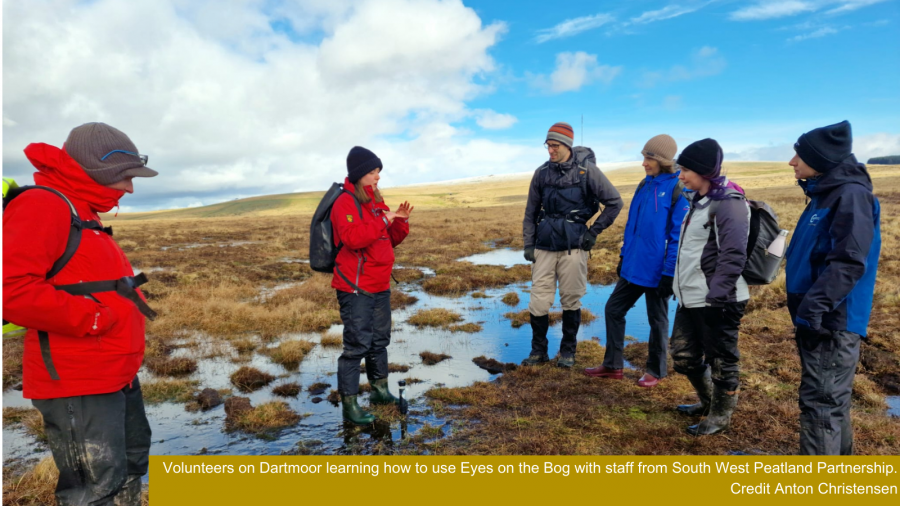
The Peatland Programme’s ‘Eyes on the Bog Fund’ is currently funding seven projects across five organisations to expand their Eyes on the Bog offering, share the data generated and support community engagement with peatlands. We hope to make Eyes on the Bog even more accessible and widely used by producing new resources, and providing training and further funding for new users.
Updates to Eyes on the Bog methods: manual version 2 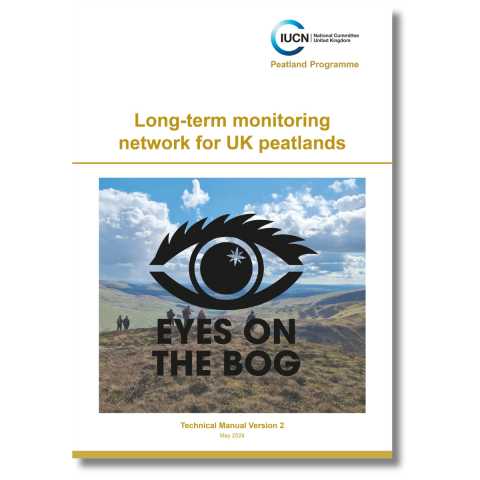
In response to feedback from Eyes on the Bog users, we have updated the manual to include new options for rust rods and more information on how to interpret and record the data from them. In some cases, rust rods failed to rust over time. We believe this to be the result of insufficient oxygen reaching the rods due to the nature of the surrounding peat, so it is now strongly recommended to place rust rods inside a plastic tube with holes drilled into it to allow water to more in and out as the water table changes. We also introduce mild steel rods as an alternative to threaded steel rods, and provide Peganox as an alternative to Noxyde paint, which is no longer readily available. The new manual also clarifies which methods are suitable for which peatland habitats.
Download the Eyes on the Bog manual version 2.
Sharing Eyes on the Bog data through PeatDataHub
PeatDataHub is an online repository for peatland data and scientific literature from across the world which aims to bring together a community of peatland researchers and maximise the impact of peatland research through data sharing. PeatDataHub includes a module for adding Eyes on the Bog data so that it can be shared across the peatland community according to FAIR data principles (findability, accessibility, interoperability and reusability).
The following video provides introductions to Eyes on the Bog and PeatDataHub and how they align.
Eyes on the Bog FAQs
In response to feedback and comments from Eyes on the Bog users, we’ve produced a set of FAQs to help answer all your Eyes on the Bog questions. If there is a question you’d like to see answered here, please contact info@iucn.org.uk.
How can I get involved in using Eyes on the Bog near me?
Anyone can set up their own Eyes on the Bog monitoring with permission from the landowner. If the site is protected, you’ll also need to consult the relevant statutory body and planning permission may be required to install totemic markers. Most volunteers work with their local peatland partnership at Eyes on the Bog sites established to monitor the impacts of peatland restoration activities, and sometimes to compare these with sites which haven’t been restored.
Can I use Eyes on the Bog on all types of peatlands?
Most Eyes on the Bog methods are suitable for all peatland habitats, except for rust rods and the von Post test which are applicable to peat bogs only. The reasons for this are explained in the Eyes on the Bog manual.
How many Eyes on the Bog monitoring locations should I use and where?
A single Eyes on the Bog location will provide useful information, just like the Holme Fen post. However, more locations will provide more detail and understanding of the area being monitored, and two or three rust rods are recommended at each location, as rusting sometimes fails to happen or is difficult to interpret. The number of points will also depend on the resources available and any questions that the monitoring is designed to answer. For example, you may wish to look at the effects of erosion features like drains or gullies, or compare a degraded site with a restored one nearby. For scientific studies, high levels of replication are needed to draw statistically valid conclusions.
How often should I check my Eyes on the Bog sites?
This depends on the specific project and capacity of staff and volunteers, but Eyes on the Bog is designed to be used at long intervals of once or twice a year. Rust rods require at least 3 months for changes to be clearly visible and probably longer if threaded steel rods are being used. When using photography to monitor changes in vegetation, it is recommended to take photographs at the same time each year, and species identification is often easier when plants are in flower. However, lots of photographs taken across the year can help understand seasonal changes, as demonstrated by the ‘Tracking the Colour of Peatlands’ project which also uses fixed point photography.
What equipment do I need and where can I buy it?
The Eyes on the Bog manual provides a comprehensive list of equipment needed for rust rods and surface-level rods, which is available from DIY stores and online. Peganox paint and the recommended camera equipment can all be purchased online. The manual also provides information on how to access aerial maps and historic photographs.
How much does it cost?
The tools needed for rust rods and surface-level rods can be purchased for around £100-200 if not already available. Each rod assembly then costs around £10 to make, although savings can be made if buying in bulk to set up multiple rods. Peganox paint costs around £50 – 60 per litre, but this can be used to paint many rods. 360 degree cameras can be purchased for around £300 – 400.
Will I be able to find the rods?
Rust rods and surface-level rods can be difficult to locate, especially if the vegetation has grown since they were installed. You can use a smartphone to record the GPS location of your sites, but your local peatland partnership may have access to a more accurate GPS device which will make locating the rods easier. Once you’re in the right vicinity, a metal detector can help to pinpoint the rods if they are difficult to spot. It’s not recommended to use a cane or post to mark your rods, as these can be removed by livestock and encourage perching birds whose droppings may affect the surrounding vegetation.
What if someone removes the rods?
Most Eyes on the Bog users haven’t experienced any issues with equipment going missing or being tampered with, especially as many Eyes on the Bog locations are remote and away from access routes, and the equipment is installed close to the ground surface. However, as Eyes on the Bog equipment may be installed close to other more conspicuous monitoring equipment such as dip-wells, and as Eyes on the Bog use increases, particularly closer to urban areas, the possibility of this may increase. Attaching small labels or QR codes which explain the importance and purpose of the monitoring, as well as how to find out more and get involved may be helpful, and it is also recommended to install more than one rod at each location.
Are the rods harmful to livestock or other animals?
We have not received any reports of livestock or other animals being injured by Eyes on the Bog rods but we do know that animals may trample them. It is therefore recommended to install more than one rod at each location to prevent any loss of data this may cause. Placing a garden cane topper or other small protector at the top of rods should also prevent any chance of injury.
What if the rods get damaged?
When choosing locations for your rods, avoid areas where machinery or vehicles might be used. If you are working on land where there are livestock and machinery in use, ensure the land manager(s) knows the locations of the rods. If you are concerned about damage, check rods as often as you can, and install more than one rod at each location, so that if one gets damaged, you can still obtain readings from another one.



